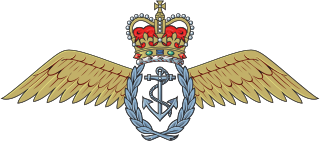| 853 Naval Air Squadron | |
|---|---|
| Active | 1943-1945 |
| Country | |
| Branch | |
| Part of | Fleet Air Arm |
853 Naval Air Squadron (853 NAS) was a Naval Air Squadron of the Royal Navy's Fleet Air Arm. [1]
| 853 Naval Air Squadron | |
|---|---|
| Active | 1943-1945 |
| Country | |
| Branch | |
| Part of | Fleet Air Arm |
853 Naval Air Squadron (853 NAS) was a Naval Air Squadron of the Royal Navy's Fleet Air Arm. [1]

The Fleet Air Arm (FAA) is the naval aviation component of the United Kingdom's Royal Navy (RN). The FAA is one of five RN fighting arms. As of 2023 it is a predominantly "rotary" force, with helicopters undertaking roles once performed by biplanes such as the Fairey Swordfish. It operates the F-35 Lightning II for maritime strike and the AW159 Wildcat and AW101 Merlin for commando and anti-submarine warfare.

Royal Naval Air Station Lee-on-Solent,, is a former Royal Naval Air Station located near Lee-on-the-Solent in Hampshire, approximately 4 miles (6.44 km) west of Portsmouth, on the coast of the Solent.
Royal Air Force Heathfield, or more commonly RAF Heathfield, sometimes known as RAF Ayr/Heathfield due to its proximity to Glasgow Prestwick Airport, which was also used by military flights, is a former Royal Air Force station. It opened in April 1941 as an airbase for day and night fighter squadrons. In September 1944 it transferred to Fleet Air Arm control and commissioned as HMS Wagtail. The Royal Navy paid off the airbase in March 1946 and it was reduced to care and maintenance. The United States Air Force used it for storage between 1951 and 1957, with the designation USAAF Station 570.

Naval Air Station Squantum was an active naval aviation facility during 1917 and from 1923 until 1953. The original civilian airfield that preceded it, the Harvard Aviation Field, dates back to 1910. The base was sited on Squantum Point in the city of Quincy, Massachusetts. It also abutted Dorchester Bay, Quincy Bay, and the Neponset River.

Royal Naval Air Station Hatston, was a Royal Naval Air Station, one mile to the north west of Kirkwall on the island of Mainland, Orkney, Scotland. It was located near the strategically vital naval base of Scapa Flow, which for most of the twentieth century formed the main base of the ships of the Home Fleet. The airbase was designed to provide accommodation for disembarked Front-Line squadrons and accommodation for disembarked Ship's Flight Aircraft and was home to the Home Fleet Fleet Requirements Unit, 771 Naval Air Squadron.
Royal Naval Air Station Eglinton was a Royal Navy airbase located 1.3 miles (2.1 km) north east of Eglinton, in County Londonderry, Northern Ireland. It opened as a Royal Air Force Station in 1941, before being transferred to the Fleet Air Arm in May 1943.

834 Naval Air Squadron was a Naval Air Squadron of the Royal Navy's Fleet Air Arm. The squadron was formed in Jamaica in December 1941 as a torpedo bomber squadron equipped with Fairey Swordfish aircraft. The squadron was embarked on HMS Archer from March 1942 to February 1943 and involved in convoy escorted duties in the Atlantic and Mediterranean. 834 NAS then joined No. 19 Group RAF Coastal Command for duties in the English Channel. In June a flight of Supermarine Seafires was formed and the next month the squadron was embarked on HMS Hunter. The squadron took part in the Salerno landings in September, before being transferred to HMS Battler to provide convoy escort duties in the Indian Ocean. 834 NAS received a further flight of 6 Wildcat Vs in April 1944 and the Seafire flight was disbanded in July. The squadron returned to the UK in November 1944 and was disbanded in December.
877 Naval Air Squadron was a Naval Air Squadron of the Royal Navy's Fleet Air Arm. The squadron formed at Tanga, Tanganyika Territory in April 1943 as a Fleet Fighter unit for local defence duties, using RAF Hurricane IIBs. In July 1943 the squadron moved to Port Reitz, Mombasa with the intention to fly with long-range fuel tanks to the defence of Ceylon but this was cancelled and the squadron disbanded in December 1943.
890 Naval Air Squadron was a Naval Air Squadron of the Royal Navy's Fleet Air Arm.
1830 Naval Air Squadron was a Naval Air Squadron of the Royal Navy's Fleet Air Arm.
1832 Naval Air Squadron was a Naval Air Squadron of the Royal Navy's Fleet Air Arm.
1835 Naval Air Squadron was a Naval Air Squadron of the Royal Navy's Fleet Air Arm.
1840 Naval Air Squadron was a Naval Air Squadron of the Royal Navy's Fleet Air Arm. During World War II over 80% of the pilots were from the Royal Netherlands Naval Aviation Service.
1850 Naval Air Squadron was a Naval Air Squadron of the Royal Navy's Fleet Air Arm.
1841 Naval Air Squadron was a Naval Air Squadron of the Royal Navy's Fleet Air Arm.
1843 Naval Air Squadron was a Naval Air Squadron of the Royal Navy's Fleet Air Arm.
861 Naval Air Squadron was a Naval Air Squadron of the Royal Navy's Fleet Air Arm.
Royal Naval Air Station Maydown is a former Royal Navy Fleet Air Arm airbase located 4.3 miles (6.9 km) northeast of Derry, County Londonderry and 11.4 miles (18.3 km) west of Limavady, County Londonderry, Northern Ireland.
{{cite web}}: CS1 maint: unfit URL (link)